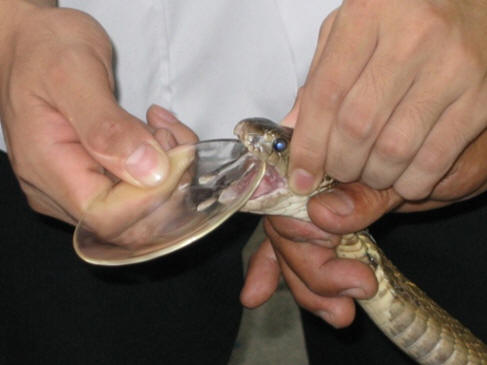Eastern Tiger Snake - Notechis scutatus
Special Weapon
What does being a venomous animal truly mean? A venomous animal is one that produces venom within a gland or a group of cells that is delivered to another organism upon a bite or sting. Snake venom is comprised of proteins and polypeptides that display toxic and enzymatic properties. The venom of snakes serves as an advantageous method for catching prey, digestion of food, and defense mechanisms. Venom aids in digestion of prey items, simply due to the fact that venom glands can be considered modified salivary glands that have the ability to be part of the digestive track. It has been discovered that prey animals, such as mice, that have been injected with venom are digested at a quicker rate.
As previously mentioned, the eastern tiger snake is one of the most dangerous and deadliest land snakes throughout the world. When looking at the number of humans that could potentially be killed based off venom yields, the mainland tiger snake could kill 11.67 humans by its mean yield and 63.00 by the maximum yield. To put it into perspective, the next deadliest land snake is the Ophiophagus Hannah, or commonly known as the King Cobra, which has the ability to kill 21.05 humans by its mean yield and 25.00 humans via its maximum yield. The venom found in Notechis scutatus is produced in large amounts. The average venom yield contained within this species is approximately 35 mg, with the highest record yield being 180 mg.

Picture courtesy of Barry Rogue from Wikimedia Commons
Notechis scutatus venom is comprised of many different components including pre and post-synaptic neurotoxins, myotoxins, and procoagulants. In particular, Notexin is a neurotoxin and myotoxic phospholipase A2 that comes from and is found within the venom of eastern tiger snakes. Neurotoxins affect the peripheral nervous system, but not the central nervous system, causing paralysis and/or muscle weakness. Neurotoxins are unable to affect the central nervous system because these specific proteins are unable to cross the blood-brain barrier. The blood-brain barrier is a protective barrier for the central nervous system that is located between circulating blood and brain tissues. These toxic phospholipases A2 inhibit the release of acetylcholine from the endplate of the nerve. Acetylcholine is a neurotransmitter that can be found within the nervous system.
Notexin is a 119-amino acid protein comprised of a single polypeptide chain that is stabilized by seven disulfide bridges. In addition, procoagulants, or toxins found within venom that effect blood clotting rate, helps contribute to the make up of Notechis scutatus venom as well. This toxin puts victims at major risk for large amounts of bleeding. Another component of the eastern tiger snake's venom are myotoxins, which are toxins causing muscle damage. In addition to the problems mentioned above, many other complications can quickly arise, upon envenomation, including renal failure, respiratory failure, and/or death. Factors

Image obtained from the Clinical Toxinology Resources website
Unfortunately, Notexin is a very complex protein, so pictures of this extremely detailed structure were not readily available.
Still urging to learn more? Head to the Just for Fun! page or begin all over again from the start.